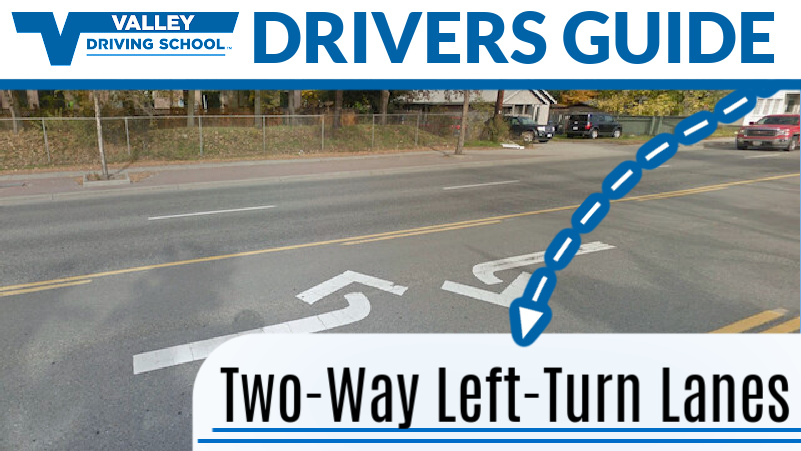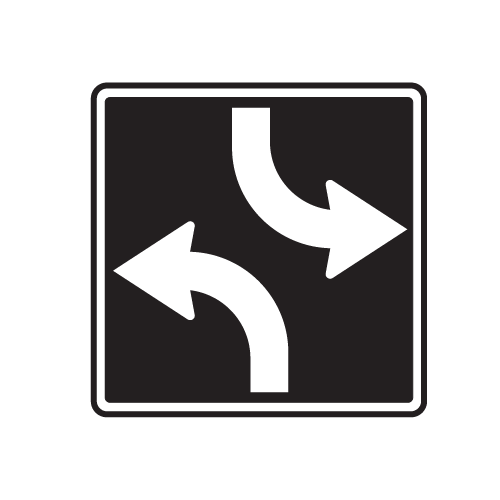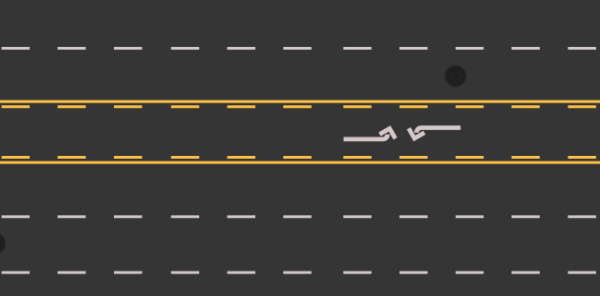Turning left in the middle of traffic can seem overwhelming but let us assure you that once you have the knowledge to face these maneuvers, you’ll be able to complete them safely and with confidence!

We’re here to help you conquer two-way left-turn lanes with ease and proficiency!
What is a two-way left-turn lane?
A two-way left-turn lane is a shared lane that allows traffic from both directions to enter and execute turns without impeding traffic behind the driver. Since traffic going in both directions is able to enter the lane, drivers should be extra aware when moving into the lane.

These lanes can be identified by watching for a few things, including the parallel solid and dotted yellow lines outlining the lane, two opposite arrows painted on the road in the lane, and a black and white sign indicating the lane. If you don’t see these indicators, it most likely is not a two-way left-turn lane.
There are also rules regarding the use of a two-way left-turn lane. Drivers cannot travel in a two-way left-turn lane unless they are planning to exit the lane by turning left, which means that drivers cannot use these lanes as a means to pass others on the road. Drivers entering a roadway that has a two-way left-turn lane must account for the extra time that it will take to cross over the two-way left-turn lane and enter into the lane of traffic. Two-way left-turn lanes are not meant to be used as a waiting space when merging with traffic, so drivers should be able to cross over the lane and enter into traffic in one swift maneuver.
How to use a two-way left-turn lane?
As you approach the two-way left-turn lane, as with any lane change, drivers should mirror check, activate the turn signal for the desired direction, and shoulder check before moving over. Activating the turn signal should be done within an adequate distance of executing the lane change. Not too soon, but don’t leave it too late either! This will alert drivers behind you that your vehicle will be slowing and it also indicates your intentions to oncoming traffic. The turn signal is important for oncoming traffic as well, as other drivers may be wanting to use the same two-way left-turn lane and we don’t want to encounter any space conflicts!

Drivers should be watching for other vehicles entering the two-way left-turn lane ahead of them, as well as vehicles entering from the opposite direction. Keep an eye out for turn signals, vehicles slowing, and vehicle positioning within their own lane as indicators that they may want to use the two-way left-turn lane as well. Vehicles that are moving closer to the lane may be getting ready to perform a lane change, even without their turn signal activated. If an oncoming vehicle is entering the two-way left-turn lane you may need to enter the lane later than you had originally intended, or even plan an alternate route or make a u-turn further down the road. As a general rule, you should aim to enter the intersection at the same point as where the opposing arrow is painted in the lane, facing in the opposite direction you are turning.
Once drivers have entered the two-way left-turn lane, they may need to come to a full stop and wait for a safe gap to turn if there is oncoming traffic, pedestrians, cyclists, or other road users. Drivers are safe to stay in the two-way left-turn lane as long as needed before it’s safe for them to proceed, and their turn signal should remain activated for the entire time they are in the lane. Before you execute the turn maneuver, you should complete a mirror and shoulder check once more to ensure there are no approaching hazards.
–
Having the theoretical knowledge that surrounds two-way left-turns - how they work and what regulations are connected to them - is the first-step for conquering these maneuvers. Now it’s time to get out on the road and apply your newfound knowledge to a practical setting! Before you attempt a two-way left-turn lane in the middle of the city, try finding one that’s in a slower or residential area. Once you have mastered the two-way left-turn without too much extra traffic and distractions, then you’re ready to move onto busier roadways.

